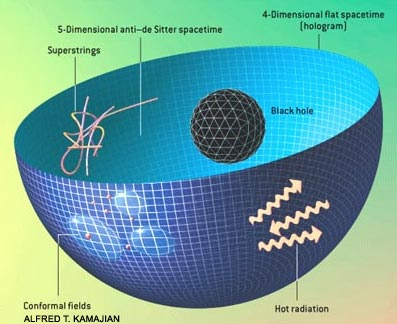Now it is obvious that this second description of falling into, or here better onto a black hole has no singularity. So how can this possibly describe the exact same physics as observed by the in-falling observer? General relativity requires her to approach a singularity, so she soon must feel very uncomfortable.
And that she will do also in the dual description: she will feel uncomfortable just the same, because in the dual description, the strings of the observer spread out all over the event horizon.
The more massive the black hole, the larger the event horizon surface, and the longer it takes to spread the strings around. In case of a very large black hole, say a super massive one which is a thousand times the size of the black hole in the center of our galaxy, it can take a day between reaching the event horizon and being ripped apart. This is because larger black holes are colder than smaller ones. Nevertheless, at some point, the strings of the observer are spread all over the surface and start mingling with the strings already there.
This is the so called “thermalization” of the observer. This thermalization is what feels like a singularity in the end. The observer hitting the singularity equals her strings being completely “thermalized” in the heat bath of the event horizon without there being a singularity in that description.

So, here we have dual descriptions once again. They are totally different yet also the exact equivalent in terms of predicted observations. They are not relative to different observers, like inside and outside observers that look at the black hole, which is another distinction that leads to complementary rather than dual descriptions. We have here only one observer! As I wrote already about the whole universe: “There is no difference between the descriptions. Being on the surface or being inside, these totally different situations are the exact same situation!”
This duality answers a possible reply to whether singularities exist in the universe. There are none! If they are at all, they are in some of your descriptions.
Straw-man: “Wait, did you not say the descriptions are dual? So the answer should be that there are none and also they are some, not that there are none. At least – something like that is what you insisted on the last time around when you were ranting about whether there is a certain number of spatial dimensions!”
Well, yes, I could be more consistent in that respect, but there is one major difference: A singularity is not observable in principle, as it would require infinite resolution (and thus infinite amounts of energy). In fact, if we look at those theories that are actually dual, i.e. where the duality is not just supported by advanced hand waving but works out mathematically, then none of the mutually dual descriptions have singularities. Take for example the AdS-CFT duality: the outside-on-membrane description without gravity on one hand is dual to a string-inside description with gravity, but the latter has also no singularity, because it is a string description. A string has always some spatial extend.
So, yes, I cheated a little, but I did nowhere explicitly claim exact duality to orthodox general relativity; I always rather carefully made sure that it is the observations of an observer that need predicting. We only need to accept general relativity as far as it is proven by observation. There is obviously never any observer ever looking at a singularity.
Anyways, I hope I have now, with three to four posts, finally gotten across that there are two separately interesting aspects of the duality here (the event horizon and the singularity) and that they are NOT just the same as the new fad that everybody drivels on about – no this is not just the same as black hole complementarity (again: there is only a single observer here) and it is also not necessary to drone on about holography just because it sounds good. Just the interesting by itself is as always interesting enough already.
Previous entries in my series on duality:
Black Hole Duality: Not Noticing Crashing with Light Speed



Comments